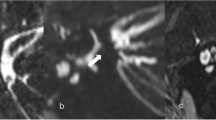Abstract
Background
A vestibular aqueduct midpoint width greater than 1.50 mm is currently considered to be pathognomonic for a large vestibular aqueduct syndrome.
Objective
To analyse the diameter of the vestibular aqueduct in children as a function of age and consequently to determine if a fixed measure could serve as a pertinent diagnostic criterion.
Materials and methods
This was a retrospective study of 200 high-resolution CT scans of the ear in 100 patients aged 0–16 years and from various paediatric medical departments. On each CT scan, the lateral semicircular canal diameter, the vestibular aqueduct midpoint width between the external aperture and common crus, and the vestibular aqueduct external aperture diameter were measured. Spearman’s rank test and the Mann-Whitney correlation test were used for an integrated statistical analysis.
Results
There was no statistically significant variability in vestibular aqueduct diameter as a function of age or sex of patients.
Conclusion
A CT scan threshold value, fixed and independent of age and sex, is thus legitimate for the diagnosis of vestibular aqueduct dilatation.








Similar content being viewed by others
References
Veillon F (1991) Imagerie de l’oreille. Flammarion, Médecine-Science, Paris, pp 221–227
Becker TS, Vignaud J, Sultan A, et al (1983) The vestibular aqueduct in congenital deafness: evaluation by the axial projection. Radiology 149(3):741–744
Fujita S, Sando I (1994) Postnatal development of the vestibular aqueduct in relation to the internal auditory canal: computer-aided three-dimensional reconstruction and measurement study. Ann Otol Rhinol Laryngol 103(9):719–722
Kodama A, Sando I (1982) Dimensional anatomy of the vestibular aqueduct and the endolymphatic sac (rugose portion) in human temporal bones: statistical analysis of 79 bones. Ann Otol Rhinol Laryngol Suppl 96:13–20
Kodama A, Sando I (1982) Postnatal development of the vestibular aqueduct and the endolymphatic sac. Ann Otol Rhinol Laryngol Suppl 96:3–12
Beal DD, Davey PR, Lindsay JR (1967) Inner ear pathology of congenital deafness. Arch Otolaryngol 85(2):134–142
Valvassori GE, Naunton RF, Lindsay JR (1969) Inner ear anomalies: clinical and histopathological considerations. Ann Otol Rhinol Laryngol 78(5):929–938
Sekhar HK, Sachs M (1976) Mondini defect in association with multiple congenital anomalies. Laryngoscope 86(1):117–125
Schuknecht HF (1980) Mondini dysplasia; a clinical and pathological study. Ann Otol Rhinol Laryngol Suppl 89(1 Pt 2):1–23
Paparella MM (1980) Mondini's deafness. A review of histopathology. Ann Otol Rhinol Laryngol Suppl 89(2 Pt 3):1–10
Shi SR (1985) Temporal bone findings in a case of otopalatodigital syndrome. Arch Otolaryngol 111(2):119–121
Valvassori GE, Clemis JD (1978) The large vestibular aqueduct syndrome. Laryngoscope 88(5):723–728
Okumura T, Takahashi H, Honjo I, et al (1995) Sensorineural hearing loss in patients with large vestibular aqueduct. Laryngoscope 105(3 Pt 1):289–293; discussion 293–294
Arcand P, Desrosiers M, Dube J, et al (1991) The large vestibular aqueduct syndrome and sensorineural hearing loss in the paediatric population. J Otolaryngol 20(4):247–250
Mafee MF, Selis JE Yannias DA, et al (1984) Congenital sensory hearing loss. Radiology 150(2):427–434
Mafee MF, Charletta D, Kumar A, et al (1992) Large vestibular aqueduct and congenital sensorineural hearing loss. AJNR 13(2):805–819
Talbot JM, Wilson DF (1994) Computed tomographic diagnosis of X-linked congenital mixed deafness, fixation of the stapedial footplate, and perilymphatic gusher. Am J Otol 15(2):177–182
Levenson MJ, Parisier SC, Jacobs M, et al (1989) The large vestibular aqueduct syndrome in children. A review of 12 cases and the description of a new clinical entity. Arch Otolaryngol Head Neck Surg 115(1):54–58
Mafee MF, Valvassori GE, Becker M (2005) Imaging of the head and neck, 2nd edn. Thieme Stuttgart New York, pp 56–57
Pyle GM (2000) Embryological development and large vestibular aqueduct syndrome. Laryngoscope 110(11):1837–1842
Nemzek WR, Brodie HA, Hecht ST, et al (2000) MR, CT, and plain film imaging of the developing skull base in fetal specimens. AJNR 21:1699–1706
Author information
Authors and Affiliations
Corresponding author
Rights and permissions
About this article
Cite this article
Legeais, M., Haguenoer, K., Cottier, J.P. et al. Can a fixed measure serve as a pertinent diagnostic criterion for large vestibular aqueduct in children?. Pediatr Radiol 36, 1037–1042 (2006). https://doi.org/10.1007/s00247-006-0263-6
Received:
Revised:
Accepted:
Published:
Issue Date:
DOI: https://doi.org/10.1007/s00247-006-0263-6




